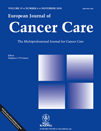Quality of life research: is there a difference in output between the major cancer types?
Abstract
SANSON-FISHER R., BAILEY L.J., ARANDA S., D'ESTE C., STOJANOVSKI E., SHARKEY K. & SCHOFIELD P. (2010) European Journal of Cancer Care19, 714–720Quality of life research: is there a difference in output between the major cancer types?
As a result of more people living with or surviving cancer, outputs for quality of life research may have increased over time to reflect the needs of the growing number of people affected by cancer. To determine if this is the case, the authors sought to examine the number and proportion of publications concerned with cancer patients' quality of life for four major cancer sites (breast, lung, prostate, colorectal) over five equal time periods (1985, 1990, 1995, 2000, 2005). A computer-based literature search using Medline and PsycINFO databases was undertaken. A comparison search with cancer-related biomedical terms was conducted. The results showed that the number of quality of life publications was substantially lower compared with biomedical publications over time, although the average annual relative increase in publications was greatest for quality of life. The total number of quality of life publications was greatest for breast cancer and lowest for colorectal cancer at all five time points. The relative increase over time of quality of life publications was greatest for prostate cancer and lowest for breast cancer. More research is needed regarding quality of life for cancer patients. Breast cancer has dominated quality of life research outputs despite a lower relative increase in publications over time compared with other cancer sites. There is need for debate among funding agencies and researchers to ensure research efforts are shared among cancer types.




